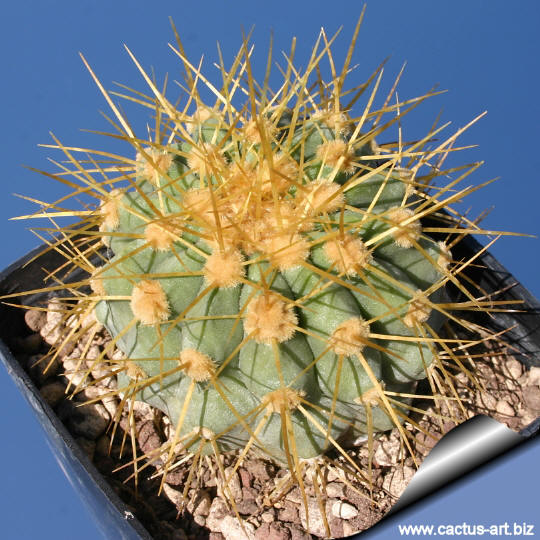|
|
|

Copiapoa gigantea LH1314 Cobota, Chile.
This is one of the most attractive of the Copiapoas it may be
distinguished from the very similar
C. haseltoniana by the shorter more numerous 'orange' coloured
spines and less wool.
|
|
 |
 |
|
. |
|

Copiapoa gigantea LH1314 Cobota, Chile.
The whitish-grey coloration is a waxy coating to
prevent desiccation in it's extremely dry environment. |

Copiapoa gigantea KK614 Paposo, Chile
Altitude: 100-300 m (ribs are more straight and without very evident
hexagonal tubercles) |
|
. |
|
 |
 |
|
. |
|

Copiapoa gigantea Nort of el Rinco 1300 m. This is a |

form from high altitude characterized by long spines. |
|


Advertising
|
|
|
|
|
|
|
Family:
Cactaceae (Cactus
Family)
Scientific name:
Copiapoa
gigantea Backeberg
In: Jahrb. DKG. 1:104 1936
Origin:
Endemic to the Atacama desert (Chile, Antofagasta) Tipically found 2 km
from Paposo, Pampa, Antofagasta ( but some authors indicate a wider area
ranging from north of Taltal up to 25-30 km north of Paposo)
Conservation status: Listed in
CITES appendix 2.
Habitat: It grows among rocks and gravel in a
scattered population at low altitude (between 100 and 1300 m over sea level)
in areas where very little else grows. As it
is common in this coastal desert climate the rain-falls are extremely
scarce, often it doesn't rain at all for many years.
It's a very drought tolerant species.
But the
extreme aridity is attenuated by the frequent, often dense,
early morning costal fog (the humidity of the
see furnish part of the water needed by this plants) . By the middle of
the morning however, the fog cover dissipate and sun breaking through
the gaps warming the ground. The nocturnal condensation is also an
important and conspicuous source of humidity, that (especially in
winter) may wet the ground down to 2 cm in depth. The root system of the
copiapoas is sallow and allows them to uptake the maximum of this
humidity.
It is a member of the
Copiapoa cinerea
complex.
Synonyms:
- Copiapoa cinerea subsp. gigantea
(Backeberg) Slaba 1997
- Copiapoa haseltoniana
Backeberg 1956
- Copiapoa cinerea subsp.
haseltoniana (backeberg) N.P. Taylor 1997
- Copiapoa eremophila F.
Ritter 1980
- Copiapoa tenebrosa F.
Ritter 1980
|
|
|
|
Description: It is
a large sized often elongated and columnar plant slowly branching from
the base, forming large, open clumps with (usually) few individual
stems. C. gigantea has the largest and stouter individual
stems among the member of the Cinerea complex.
Stem: Globose to cylindrical, up to 1 m (or more) high, 20-30 cm
across, pale olive-green, grey-green or ash-grey, the apex is very
spiny, covered with reddish, orangish or yellowish-brown wool.
The whitish-grey coloration is a waxy coating presumably to prevent
desiccation in it's extremely dry environment. In cultivation the white
waxy bloom is often not produced, revealing a brownish epidermis.
Ribs: 14-22(-37), rounded, broad, obtuse,
wavy, almost straight, thickened at areoles (tuberculate), becoming
flattened. The ribs in the younger specimen have very geometric and
conspicuous tubercles, typically with a hexagonal base.
Areoles: Up to 18 mm in diameter, orangish, fading in grey as
they become older.
Radial spines: 7. 1-2 cm long horny-yellow to orange coloured,
terete, tipped darker, spreading,
straight or slightly curved
Central spine: 0-1(-2)
Flowers: Yellow funnelform, 1.5 to 2.5 cm in diameter. The
Ovary is naked; it needs a lot of sunlight to bloom, so it's pretty
rare to have blossoms when in cultivation in greenhouses.
Fruit: 1.5 to 2 cm. long;
Seeds: Black and shining.
Note: C. gigantea is a
controversial taxon strictly related to
C. cinerea, but with thicker stem diameter and with thinner,
needle-like spines and often indicated as a synonym of
C. cinerea var. haseltoniana. Nevertheless C. gigantea
may be distinguished from C. haseltoniana by the
shorter more numerous 'orange' coloured spines and less wool (But the
habitat areas of these two species overlap and some authors believe that
they are the same, hence synonyms).
|
|

Copiapoa gigantea KK614 Paposo, Chile Altitude: 100-300m
This is a variable species, as is demonstrated by the
number of synonyms. The several classifications and
reclassifications provide evidence of the confusion that rules regarding
the names used in this variable species. It seems that many of botanists
and hobbyists who have studied Copiapoa in habitat have formed their own
concepts of what names should be applied to which plants. It is
relatively easy to attribute some key features that dominate in certain
populations, but it is equally possible to look more closely at plants
in these populations, to find individuals that 'break the rules' and
would easily fit another population's dominant characteristics.
Cultivation: This
extremely slow growing cactus is kept for the beauty of its form. It
must be protected from excessive heat and sun in
summer, and seems to do best in cultivation with a bit of shade.
It requires light but regular waterings in summer, but let the
soil mix dry between waterings, Prone to rot
if over-watered. Needs good drainage. Keep warm and
dry in winter (10°C) to avoid rot. Not highly tolerant of a
great deal of frost. (Frost tolerance 0°C)
Propagation:
Seeds (or offsets if available),
Grafting is often used to speed growth rate and to create a back-up to
plants in collection.
Photo of conspecific
taxa, varieties, forms and cultivars of
Copiapoa cinerea
complex. (This taxon has lots of synonyms (like most
copiapoa, with several controversial varieties and subspecies):
|
|